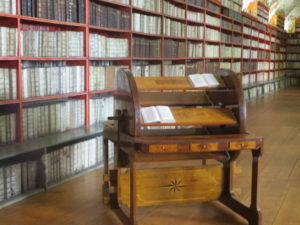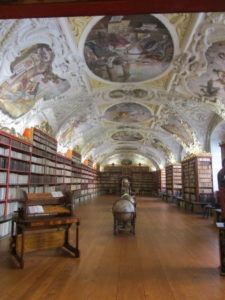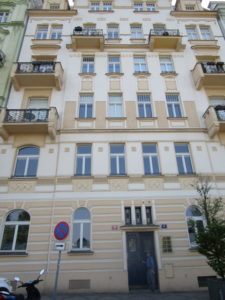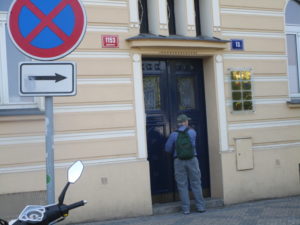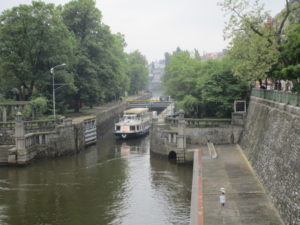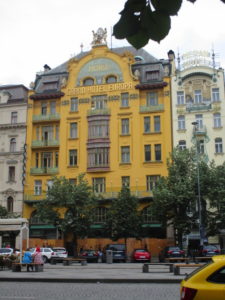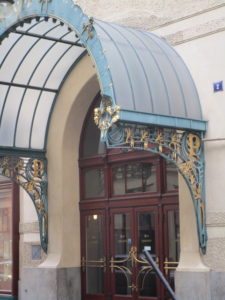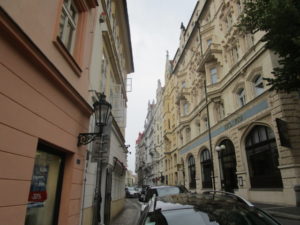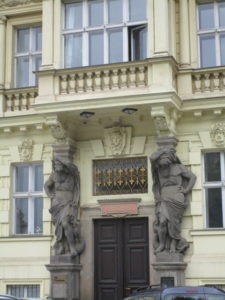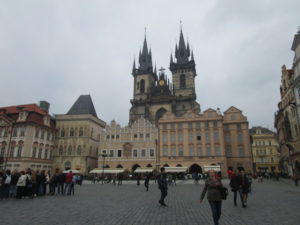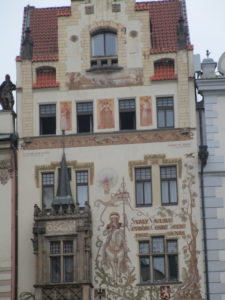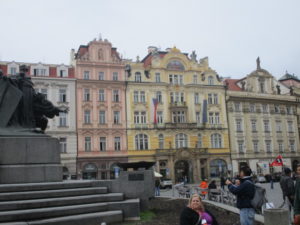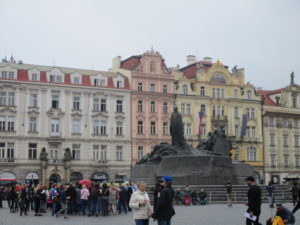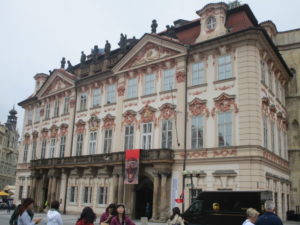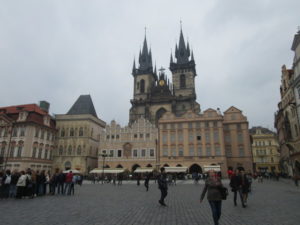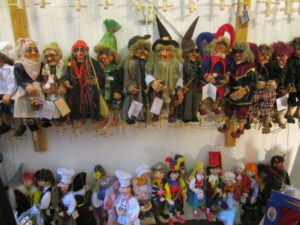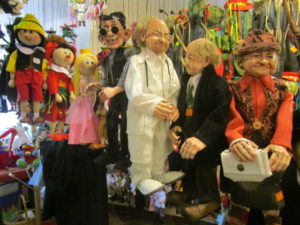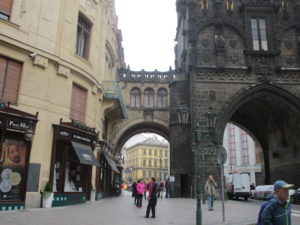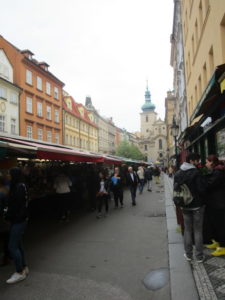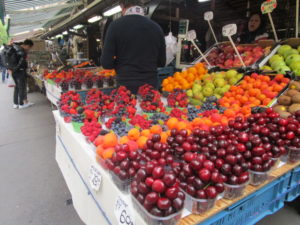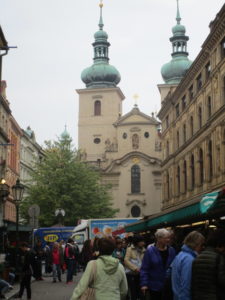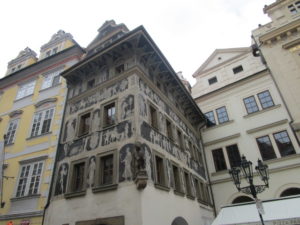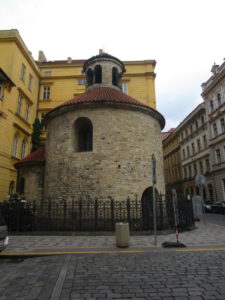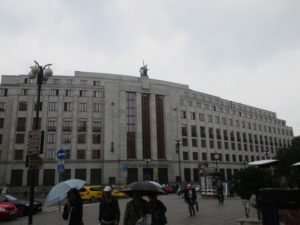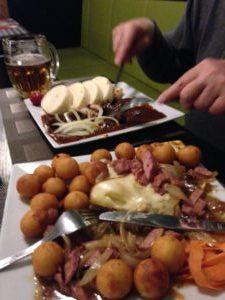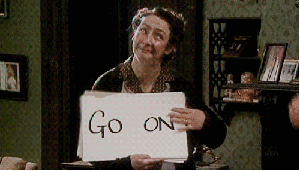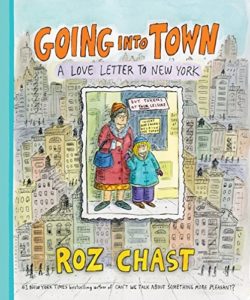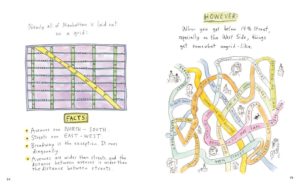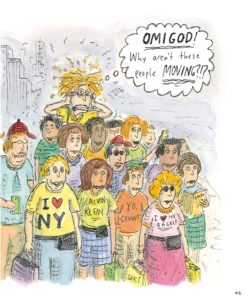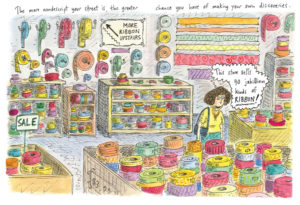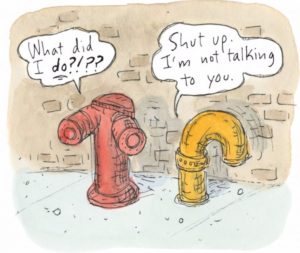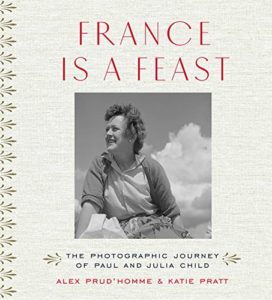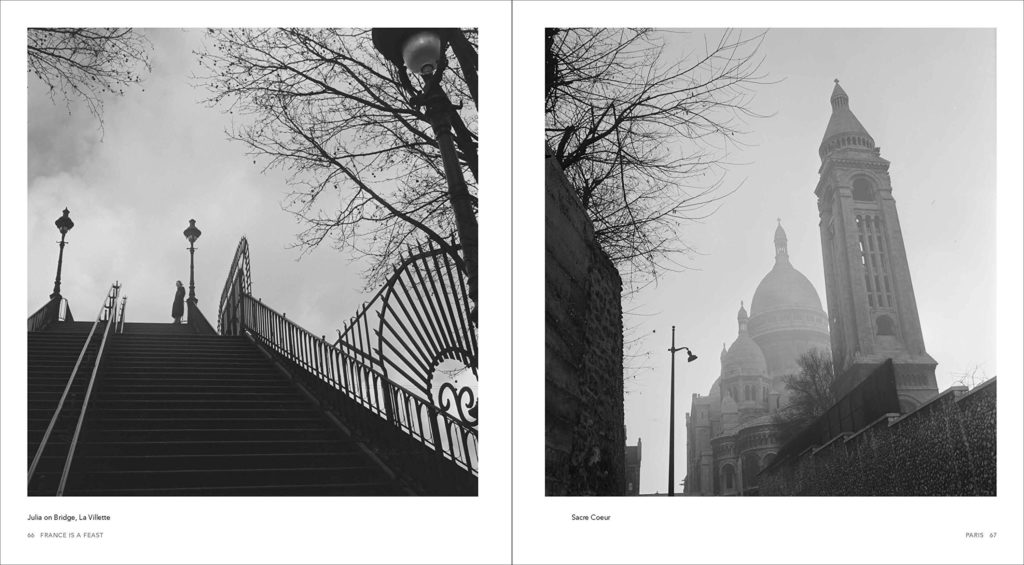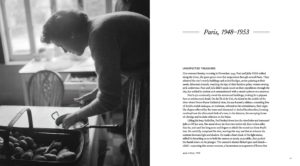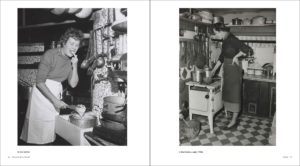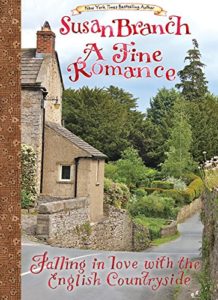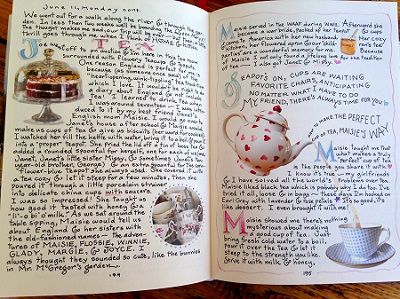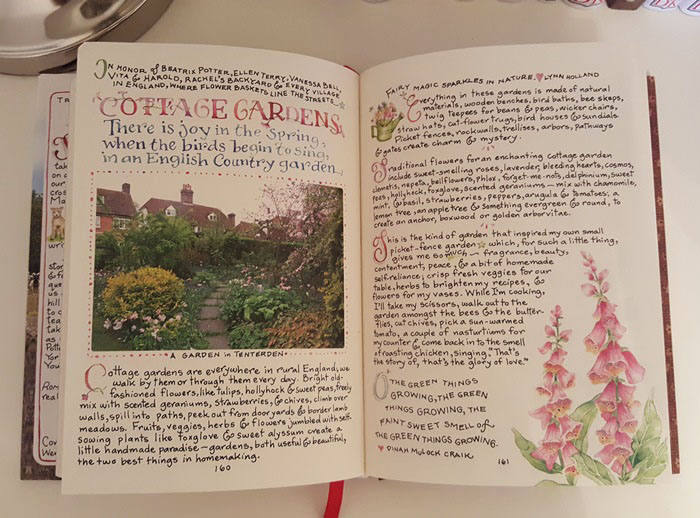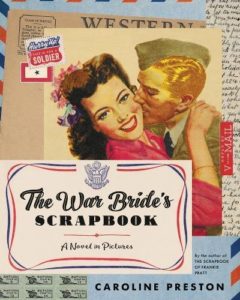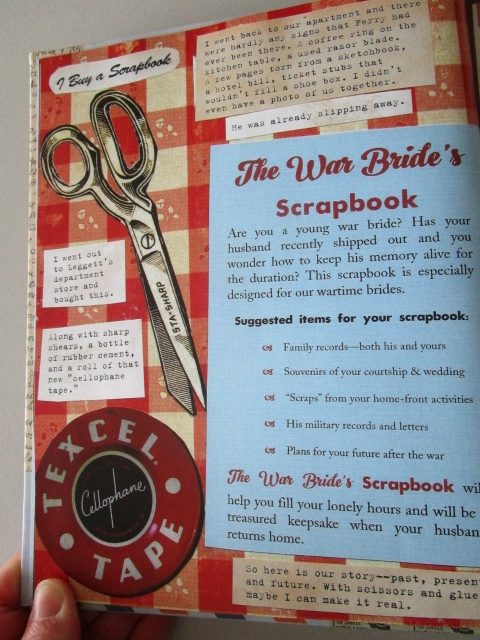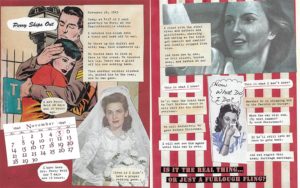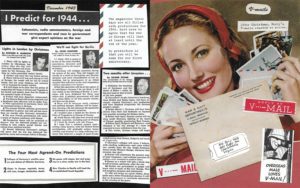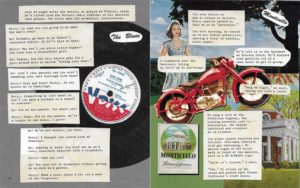Prague Day 2, in which I geek out
First a correction on yesterday’s post, both Prague’s Old and New Towns are located on the East side of the Vltava river. (This is why Husband is in charge of navigation.)
Today we explored the West side of the river – the Castle quarter – the area of the famous castle which dominates the Prague skyline. In an effort to save our feet and leg muscles, we took the tram to the top of the hilly quarter, resulting in lovely downhill treks for the day.
We started up at the Strahov Monastery and its library (one of the world’s famous libraries and on my bucket list). And oh my, dear readers, what a library (warning, this is where I loose my mind a bit…).
Strahov was a medieval monastery that functioned not only as a place of worship and learning, but also as a world famous brewery. The beer hall and brewery are still in full function today. Couldn’t find a happier place for BookBarmy and Husband.
First we’ll visit the library with an official photo (cause you just have see it photographed by a professional), then my attempts from the doorway. You have to stay in the hallway and crane your neck to peer in at the 10-17th century books all basking under elaborately painted ceilings. (Only my fear of international arrest and a Hague trial prevented me from jumping over the barricades to run through this glorious space.)
First the publicity shot, then my photos…
This last photo are xylotéka, a collection of 68 “tree books” made by Karel of Hinterlagen around 1825. Fascinating — each “volume” is really a box documenting one European tree. The box cover is made from the wood of the tree and covered with its bark and any lichen that grew on that specific tree. Inside each box, are different parts of that tree – a root, a twig, a leaf, a dried piece of its fruit, even its insects, such a beetles. The boxes are protected behind glass though, so you can only see them from the outside. This Strahov xylotéka is one of only two such collections in Europe. (I warned you I would geek out.) There were other specimen books, holy books, and a gold locked case at the far end of the library, which contained libri prohibiti — books by Copernicus, Rousseau, and (mon deau) the French encyclopedia.
Walking a bit above the ground and well past lunch time, I was gently led over to the Monastery brewery. We considered eating in one of the many beer halls which go on forever – room after room of long tables in dark stone halls. (Turns out this is a revenue enterprise today hosting bachelor parties and drunken corporate events.) We chose instead to eat outside, given such a lovely day. Met some lovely ladies with beautiful dogs – the dogs communicated for us over our language differences.
Husband reluctantly posing — but trust me he was smiling over his beer.
Sorry folks, but the rest of Day 2 in Prague will have to wait as sleep calls.
Prague ~~ Day 1
We flew to Helsinki and then here to Prague. Arrived Wednesday evening and a driver associated with our home exchange apartment (normally an AirBnB), met us at the airport. A very nice plan as we didn’t have to worry about finding the place. When we arrived, we were met by our home exchanger’s son who showed us around, recommend a couple of restaurants in the neighborhood and the closest grocery market. A student with perfect English, he was in the midst of exams, so handed us the keys, gave us his phone number (if we needed anything) and was blessedly quick (given our travel weariness).
Here’s the building with our apartment – we’re on the second floor in back overlooking a little rooftop garden next door. Husband as photographic perspective for the very large front door.
The apartment is on a dead end which faces the Vltava river, so it’s very quiet. We slept like logs and woke early for Day 1 in Prague.
Here’s the river overlook across from the apartment.
This river divides Prague into two sections Old Town (10th century) and New Town –(new meaning only 600 years old). First something very interesting. We thought our trip was to travel through Eastern Europe — Prague, Vienna, Bratislava, Budapest. But it turns out the residents of these cities/countries prefer it be called Central Europe – we are, in fact, in the exact center of Europe. Eastern Europe harkens back to Soviet rule. So Central Europe it will be.
We donned rain jackets (off and on showers) and head out to do Rick Steve’s old town walking tour. Decided a rainy weekday might avoid the hoards of tour bus groups Rick warns about.
First, we had a wonderful breakfast at a local café, eggs scrambled ever so lightly with cheese and homemade bread to die for. Even with two coffees and bottled water the entire breakfast came to $9. Prague, it seems, is going to very affordable. Noticed as left the café that good Czech beer is less than $2. Husband is in a very good mood.
We crossed one of many bridges and watched some locks in action.
We wandered back streets towards the Old Town area and marveled at the buildings and architecture . Prague is known not only for its medieval and Baroque architecture, but also for some fabulous Art Nouveau buildings and facades.
Suddenly we came into the Old Town Square
We spun slowly to take in all the diverse architectural styles – from Gothic to Rococo to Baroque and more Art Nouveau. Prague is largely so beautifully persevered because it was spared bombings during WWII that leveled so many other Eastern– Central European cities. Sorry for the clouds and rain, but you’ll get a taste of it all.
Dodging rain showers we ducked into some of the less tacky shops. Such as this fascinating, but somewhat creepy, marionette shop.
More of our self guided tour and exploring some side areas.
We went over to Wenceslas Square which was once (Rick says) a thriving horse market, but now contains every possible fashion store, fast food chains and sausage stands. Spied a Marks & Spencer (a British department store chain) so went up to their café for a proper cuppa of British tea – a much needed break.
Did some more exploring of Old Town area but then suddenly feeling very tired, we headed back to the apartment, rested up, and had a dinner at a neighborhood restaurant. I’ll leave you with two images ~~
First, we walked by this office building, a reminder that, not very long ago, Prague was under Soviet rule.
Another reminder of tougher times. Our dinner at a restaurant near our apartment, was delicious but dominated by stewed meat, dumplings, cheese and potatoes — that little dash of orange –lower right – that’s a scant 1/4 cup of carrot shavings – the only vegetable in sight.
Travel Barmy
I haven’t been every where. But it’s on my list
Susan Sontang
Well Barmy followers, we’re off again — this time to Central Europe.
We leave next week and the list of things to do is sobering. Absentee voting, preparing the house for our exchange partners, but the most challenging will be cramming everything into a backpack.
Yes, we are packing light this trip, as we’ll be traveling solely by train and bus while visiting several big cities. So in a moment of madness, and after watching an inspiring ‘packing light with Rick Steves video’, I agreed with the notion that we would each take one (that’s one) backpack. Thank goodness for my compact little Kindle full of unread books.
First stop; Prague. Watch this space for photos and travel journal. Please be kind and ignore us wearing the same clothes. (We will have washing machines in each apartment we’re staying, so our clothes will be clean, but may look vaguely familiar.)
In the meantime, I’ll re-post one of my most popular blog entries…
~~~~~~~~~~~~~~~~~~~~~~~~~~~~~~~~~~~~~~~~~~~
 The Un-Comfort Zone
The Un-Comfort Zone
The joy (and the challenge) of travel is often what I call the un-comfort zone. And the in-transit part really proves that concept. California to Europe is a grueling 11-12 hour flight.
At first, one anticipates this time as a delightful sort of suspended animation — so much time to read. But, by hour 6 you have lost all interest in reading, watching movies or being civil to your travel companion. By hour 7, you are slipping in and out of sleep in a semi-conscious state. Hour 9 – and you are ready to admit that traveling is the pits and consider a second mortgage to upgrade to first class. By the last two hours you are picking at the in-flight breakfast, looking at your watch and secretly wishing you had stayed home with NetFlix.. The flight ends and you glare at the annoying guy in front of you who spent the entire flight with his seat fully reclined into your lap. And with with crusty eyes and swollen ankles you stumble off the plane.
Then you find your way to the train (let’s see train in German — Bahn?) and check into the budget hotel you found right next to the train station. Your room overlooks a busy street corner and you wonder how you will sleep. After quick showers (and figuring out said same shower system) you feel almost human and together you strike out to walk around, get some fresh air, daylight and try to adapt to the new time zone. A light meal is in order so you choose a cute cafe with outdoor seating and order the inevitable room-temperature drinks and an overpriced salad to share. You start to relax – watching the locals come home from work and you sigh with happiness. The blatt blatt of the European police car in the distance, the striking of the church bells, and your surly waiter all secure the fact — you have arrived.
You are far away from home. A familiar world where you understand the plumbing, a world with cold drinks (and ice), a place where you don’t have to give serious thought to every choice — and all in a language you fully comprehend.
This is the joy and pain of what I call the un-comfort zone. One has to embrace the discomfort — because this is what kicks your butt out of your safe, easy and predictable world — you have shaken off your soft world and taken on one that is often confusing, uncomfortable yet inevitably fascinating, beautiful and eye-opening.
This is why you travel – this why you are here.
No! I Don’t Want to Join a Book Club by Virginia Ironside
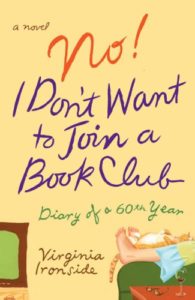 A joke birthday gift from a friend, No! I Don’t Want to Join a Book Club languished on my shelf for several years now. I plucked it out the other evening, needing a break from a serious read.
A joke birthday gift from a friend, No! I Don’t Want to Join a Book Club languished on my shelf for several years now. I plucked it out the other evening, needing a break from a serious read.
Virginia Ironside is a British humor writer well known for her writings about getting older. She’s also an agony aunt (British for advice columnist) with a column in the Independent, and once had a one-woman show,’Growing Old Disgracefully’.
In this novel/fictionalized diary, Marie has just turned sixty and decides to chronicle her life. Often funny, sometimes a bit sad, and usually snarky, this book has a cover blurb that calls it an AARP-issued ‘Bridget Jones Diary’.
She has a curmudgeonly outlook on growing old gracefully,
~~ or not:
The thing is: I don’t want to join a book group to keep young and stimulated. I don’t want to be young and stimulated anymore.
I’ve done fascinated, I’ve done curious. I want to wind down, I want to have the blissful relief of not being interested. Like being able to spend a day doing nothing instead of being obliged to cram it with diversionary activity to avoid guilt and anxiety.
Ms. Ironside uses the diary format to up the humor. She calls memory lapses CRAFT moments — as in ‘can’t remember a f***ing thing’. She journals about a party discussion wherein no one can remember an actress’s name from a famous film. Then two days later, this appears as the single entry, ‘Glenn Close’.
Here she argues with a friend, who talks about getting older as a time to have adventures and learn new things: Marie just wants to put her feet up and ‘start doing old things’.
That’s what’s so great about getting old. You no longer have to think about going to university, or go bungee jumping. It’s a huge release! I’ve been feeling guilty about not learning another language for most of my adult life. At last I find that now, being old, I don’t have to! There aren’t enough years left to speak it. It’d be pointless!
Marie’s life is constantly changing and evolving, there’s the arrival of a grandson, and the loss of some dear friends. And, although she hasn’t had sex in five years, she doesn’t lose sleep over it. She’s thinking of giving it up – unless a nice, rich and attractive crush from her childhood can change her mind.
This novel is an honest look at life as we age and, at times, I found it both touching and humorous.
However, half way through, the journal format starts to loose it’s charm and her continued grumpy treatises on the same points became tiresome.
Ms. Ironside has much more to say about being old (sorry, older) as there are two other books the Marie series all with equally funny titles: No I Don’t Need Reading Glasses and No Thanks, I’m Quite Happy Standing.
The title cracked me up, but sadly No! I Don’t Want to Join a Bookclub got put aside unfinished. Marie (and the author) would be OK with that, she would understand and give me a high five — it’s our age –we don’t have to finish a book or go bungee jumping.
N.B.: While we’re on the subject of humorous essays on aging, I found Nora Ephron’s “I Feel Bad About my Neck” and “I Remember Nothing” ever so much better, and well worth whatever free time you have when not learning Swahili.
The Chinese Shawl by Patricia Wentworth
Where I have been that I’d never read any Miss Silver mysteries? Naturally, I was aware of this series and even have had one on my shelf for ages. But not until my friend (and devoted Book Barmy fan), Sally mentioned this series, did I crack open The Chinese Shawl.
But first a trip down memory lane. If you want to get right to the book you can skip this. But, you’ll miss a good story.
Let me take a moment to tell you about Sally. Sally is my mother’s best friend. They met in the 1960’s through a babysitting club where young parents on a budget exchanged free babysitting. I’ve now forgotten the nameless mothers (and sometimes fathers) who came to babysit when my parents went out. Except one — Sally, who came over in black Capri pants and a red sweater. Sally exuded Glamour with a capital G. Beautifully coiffed hair, dramatic eye makeup framing brilliant aquamarine eyes, and she smelled really good — I think it may have been Chanel No. 5. Sally brought exciting new-to-us books from her own children’s library. My little brother and I snuggled up next to this exotic creature as she read aloud.
Sally was, and still is, a cross between Elizabeth Taylor and Mary Poppins. Turns out her daughter was my age, she had a son my brother’s age and two other little ones who were my littlest sister’s age. Her husband and my father shared a love of cars and woodworking. So our families soon became close and we all grew up together in the suburbs of D. C.
To this day, Sally, my mother and I share a secret love of cozy mysteries both on TV (yes, Murder She Wrote – don’t judge) and on the written page (talking about you, Dame Agatha Christie). The other day Sally sent an email admitting she had binged watched some old Murder She Wrotes and while embarrassed, they got her out of a funk. She went on to say that she greatly admired Patricia Wentworth’s Miss Silver series on whom it is reputed Agatha Christie stole based her own Miss Marple character. I remembered my mother also admired the Miss Silver series, so I rummaged through my piles of books book collection until I found The Chinese Shawl and dove right in.
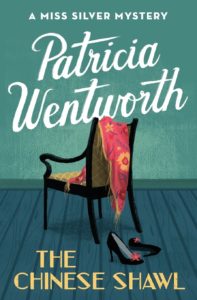 This is the story of Laura Fane, whose parents died while she was quite young and left her a historic estate called The Priory. Laura didn’t have the funds required to maintain The Priory, so was forced to lease it to her wealthy Aunt Agnes. Now that Laura has turned 21 and gained her inheritance she has come to the Priory to determine if she wants to inhabit or sell it to her Aunt Agnes and her other niece Tanis Lyle. Laura soon discovers there is family bitterness over old wounds, and this bitterness is personified most strongly by Tanis Lyle. Tanis is known for stealing other women’s boyfriends, then unceremoniously dumping them. We soon realize that Tanis has many enemies who could happily kill her. And dead she turns up.
This is the story of Laura Fane, whose parents died while she was quite young and left her a historic estate called The Priory. Laura didn’t have the funds required to maintain The Priory, so was forced to lease it to her wealthy Aunt Agnes. Now that Laura has turned 21 and gained her inheritance she has come to the Priory to determine if she wants to inhabit or sell it to her Aunt Agnes and her other niece Tanis Lyle. Laura soon discovers there is family bitterness over old wounds, and this bitterness is personified most strongly by Tanis Lyle. Tanis is known for stealing other women’s boyfriends, then unceremoniously dumping them. We soon realize that Tanis has many enemies who could happily kill her. And dead she turns up.
As it happens, Miss Maud Silver, amateur detective is already a guest at the Priory. And, the Superintendent sent to investigate the murder was a young charge of Miss Silver when she was a governess. So the investigation proceeds with lively exchanges between these two. Miss Silver gently chiding her “dear Randall” over his hasty judgments and guiding his efforts — all while clicking away on her knitting needles. The Priory setting is beautifully rendered and Laura is a nicely developed character. There are plenty of suspects from jilted boyfriends, to angry ex-girlfriends, to a pilfering maid.
As all this is going on, Laura is falling in love with a handsome war veteran and one of Tanis’s discards. It’s a old-fashioned 1920’s style courtship but Ms. Wentworth adds just the right bit of heavy breathing Just read this exchange between the couple as they first fall for each other:
“I shouldn’t be surprised if it meant that we were falling in love.”
She changed colour, but the change was to white, not red. She looked for a moment as if she had been shocked right out of her senses. There was a rushing around in her ears like water, like great waves. And then Carey saying her name urgently
“Laura – what’s the matter?”
“I – don’t – know”
Then he saw the colour come back and her lips begin to tremble.
“Laura are you alright?”
“Yes, she said.” He was holding both her hands.
“Would you mind if I fell in love with you? Because I’m going to.”
“You’ve only got to look me in the eye and say you don’t want me to fall in love with you.”
Laura’s tongue was suddenly loosened “What would you do if I did?”
He said, “Fall a little deeper.”
I was totally engaged by this splendid mystery. The suspects are characters in and of themselves. I enjoyed them all, but also tried ascertain their motives, could they have done the deed? There’s some great writing, such as this small passage:
It was the entry of Lucy Adams which broke the tension. Flushed with hurry, on the edge of being late, clanking with chains, bangles and assorted brooches, she plunged into the midst of the situation without the slightest idea that it existed.
I had a great time with Miss Silver and the Superintendent, as we solved the crime — actually they solved it — I still hadn’t quite figured out in the end.
 Stereotypical? Certainly. Similar to Miss Marple series? Of course.
Stereotypical? Certainly. Similar to Miss Marple series? Of course.
I’ve learned the 1920’s Miss Silver series, while lesser known than Ms. Christie’s, set the standard for cozy mysteries solved in old estates, with lots of fun characters, cups of tea, and charming old (OK Older) ladies who knit.
Count me in any day.
A Lowcountry Heart by Pat Conroy
Have I told your about Pat Conroy? I’m a card-carrying adoring fan.
Mr. Conroy wrote books unlike anyone else, he was a magician storyteller and wove tales that explored the many layers of human nature. Fearless in his writing, his perfect wording could give any character or life event a voice — the frail families of the old South, uncertain love, the angst of loyal and betrayed friendship, the pain of suicide, and the infinity of human flaws — really, just awe-inspiring.
Cancer took him quickly in 2016, at age 70.
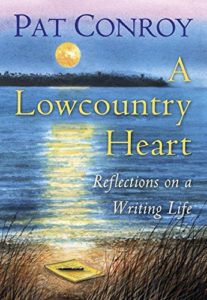 A Lowcountry Heart is a collection of his blog entries, articles, speeches and letters but also contains writings and eulogies by those that loved him. But fear not, this slender volume never treads into the saccharine, but instead is a joyful reflection of his life and times. Mr. Conroy shares his time in Vietnam, teachers in his life, his beloved Citadel, his adored second wife, and of course his love for the South Carolina lowcountry –the lifeblood of his books and his life.
A Lowcountry Heart is a collection of his blog entries, articles, speeches and letters but also contains writings and eulogies by those that loved him. But fear not, this slender volume never treads into the saccharine, but instead is a joyful reflection of his life and times. Mr. Conroy shares his time in Vietnam, teachers in his life, his beloved Citadel, his adored second wife, and of course his love for the South Carolina lowcountry –the lifeblood of his books and his life.
When his publishers advised him that he should start a blog, Mr. Conroy hated the idea but then took it as a challenge. He used it as both a journal and a way to reach out to his readers. His blog posts always began with “Hey out there,” and closed with “Great love…”.
Unlike many authors Mr. Conroy loved book tours and especially meeting with his readers.
It (book tours) is part of the covenant I sign with Doubleday that I’ll do everything possible to help the sell the book, including not getting drunk on tour or embarrassing my publishing company with my cutting-up on the road. I go out to sell books and it has become one of the greatest things about being a writer during my lifetime. No writer should turn down the chance of meeting the readers of his work.
His book signings often went late into the night because he wanted to speak personally, and at length, with each reader. They opened up to Mr. Conroy because he asked, “so, what’s your story?”. (I wonder what story I would’ve told…)
Mr. Conroy could have easily been a Southern ‘good old boy’, but it turns out he was a role model of humanity and progressiveness. He actively supported racial equality, even having a public meeting with Dr. Martin Luther King at a time when race was still a heated issue in southern society. On learning that a stranger and fellow southerner was dying of AIDS, Conroy went to be at his side so he wouldn’t die alone. Once, accidentally in a gay bar, he danced with a man because his mother raised him not to hurt anyone’s feelings.
His wife and fellow author, Cassandra King wrote the introduction to A Lowcountry Heart — a beautiful piece of writing I read several times.
The book also contains his 2001 Citadel commencement speech — I’ll just say, I found myself trying to read it through my tears.
Mr. Conroy is likely best known for his books (and the films based on his books); The Lords of Discipline, The Prince of Tides and The Great Santini.
But instead, get thee to your favorite library or bookstore read my favorites; The River is Wide, Beach Music, and South of Broad.
I’ll leave you with this, perhaps the most compelling part of this collection; Mr. Conroy is buried on a small island off the coast of South Carolina , in a modest cemetery of a Gullah Baptist church among a community that “graciously allowed a non-Baptist, non-African American writer to rest among them.”
A digital review copy was kindly provided by Doubleday Books/Nan A. Talese via NetGalley
A Picture is Worth a Thousand Words
I’ve been gathering some picture books to tell you about all at once. This winter, I enjoyed these visually enchanting escapes which took me from the streets of New York, to France, and even wartime England.
Well, grab a beverage of choice and sit right down next to me and let’s look at them together.
~~~~~~~~~~~~~~~~~~~~~~~~~~~~~~~~~~~~~~~~~~~~~~~~~~
Going Into Town
A Love Letter to New York
by Roz Chast
When Ms. Chast’s daughter was preparing to move to Manhattan for college, Ms. Chast wrote up a tongue-in-cheek guide book with tips for suburbanites navigating the city. This little booklet turned into Going Into Town: A Love Letter to New York which is a cartoon book about all the things Ms. Chast appreciates — or doesn’t— in the city she loves.
I love Ms. Chast’s work and always chuckle at her cartoons in the New Yorker magazine, on greeting cards, or her books. Remember THIS?
This book is a collection of stories and visuals — the “overheard and the overseen”, on the streets of New York — and Ms. Chast is her usual funny and cynical self.
She starts with a brief background on how she and her family moved out of the city to the suburbs for the better schools and the chance to have actual trees. But the downside was that her daughter had no city skills when venturing to university in the city.
There’s an introduction to the geography of Manhattan
Diners are all but extinct, hawks aren’t, Uber cars outnumber taxis, and in GENERAL:
3 blocks = 1 avenue
20 blocks/7 avenues = 1 mile
even streets run east, odd run west, crosstown run east-west
Going Into Town then goes on to describe the people you’ll encounter, with special warnings about the tourists…
It is evident throughout the book that poor Ms. Chast greatly misses living in the city. There’s a section on the things to do from the obvious Broadway musicals and gallery openings to the more obscure — “best hat on a dog contest”. She advocates looking — really looking — as you walk around — freshly seen through her quirky visual lens.
While Ms. Chast may have wanted to give her daughter a straightforward guide to the city, she can’t help herself and interrupts the narrative with delightful digressions about such things as the quirky stores that sell nothing but ribbon or enticing off-brand lipstick.
or the city’s great variety of standpipes,
As the title says, this is Ms. Chast’s very own love story to New York:
I feel about Manhattan the way I feel about a book, a TV series, a movie, a play, an artist, a song, a food, a whatever that I love. I want to tell you about it so that maybe you will love it, too. I’m not worried about it being ‘ruined’ by too many people ‘discovering’ it. Manhattan’s been ruined since 1626 , when Peter Minuit bought it from Native Americans for $24.00.
And, if like me, you’re stuck on the opposite coast – you’ll have a hankering to follow the author’s advice:
One of the greatest things you can do in life is walk around New York
~~~~~~~~~~~~~~~~~~~~~~~~~~~~~~~~~~~~~~~~~~~~~~~~~~
France is a Feast
A Photographic Journey of Paul and Julia Child
by Alex Prud’ Homme & Katied Pratt
From the coauthor of My Life in France, this volume is a collection of the photographs taken by Paul Child during his and Julia Child’s years in France.
This is a sometimes fascinating look at the lesser-known Paul Child, who in fact, was a talented artist, photographer, painter, lithographer, woodworker, metalsmith, stained glass expert, writer and poet.
Here’s just a sample of his fine photographic eye:
But Paul also delighted in photographing Julia:
She[Julia] was ten years younger than Paul, and not well known at the time, but she was a sunny, questing, powerful personality who had a profound impact on her husband’s evolution. He adored her and photographed her constantly; without realizing it at the time, he was chronicling her rise from a fumbling know-nothing in the kitchen to an accomplished cook and author, and America’s first celebrity TV chef.
Because of my slight obsession with Julia Child, I found myself lingering on those iconic photos:
My Life In France was one of my favorite books about Julia and Paul’s life in France and I had high hopes for this photographic essay. However, their relationship is sketched over and the often pedantic writing is focused on Paul Child, his career and interests. The final pages are devoted to the Child’s move back to Cambridge and Paul’s decline which Julia handled with courage and grace. Don’t get me wrong, I wanted to know more about Paul Child but I often lost interest. Perhaps he will always remain in Julia’s shadow.
The photographs are fascinating and France is a Feast for the eyes, but alas, not the writing.
~~~~~~~~~~~~~~~~~~~~~~~~~~~~~~~~~~~~~~~~~~~~~~~~
Falling in love with the English Countryside
by Susan Branch
A friend gave me an Amazon gift card for Christmas and I quickly ordered A Fine Romance. I had longingly thumbed through this beautiful book in a little bookstore ages ago and added to my list of “someday books”. Well, this past January was that someday.
This is not a travel guide, there is no agenda here other than to entertain and delight the reader A Fine Romance is a hand-written, illustrated chronicle of Ms. Branch’s visit to England with her husband. I lingered over almost every page — each watercolor is a tiny jewel — all interspersed with photographs, her reflections and observations
Here I’ll show you:
I read bits of this book each morning (with the obligatory cup of tea) in order to slowly savor the experience of going along as they roam the English countryside.
The book opens with the story of how the divorced Ms. Branch met Joe, which proved a bit tedious as well as, well, creepy. Here’s the creepy bit; on one of their first dates, she asked for two hotel rooms but behind her back he reserves only one. She’s surprised,unsure but just goes along with it. (Say what? Ever heard of respect for boundaries?)
This little niggle in no way detracts from the charm of the book (I just had to make that comment).
Apparently Ms. Branch has a huge following and has an impressive website with recipes, events and merchandise which sports her watercolors on everything from calendars to party favors. A bit over the top for my taste, but take a look HERE to see what you think. She also has a BLOG which I enjoy, especially the travel entries, just to admire their elegant travel style — always accompanied by a great deal of luggage.
A Fine Romance is not only for Anglophiles, but for anyone who likes pretty villages, cozy cups of tea, and beautiful gardens. Part travelogue, part diary, part sketchbook, part personal scrapbook — A Fine Romance is just wonderful.
~~~~~~~~~~~~~~~~~~~~~~~~~~~~~~~~~~~~~~~~~~~~~~~~~~
The War Brides Scrapbook
by Caroline Preston
I loved Ms. Preston’s previous novel, The Scrapbook of Frankie Pratt ,a gift from my sister. So I had to purchase another “someday” book — her newest scrapbook novel, The War Bride’s Scrapbook.
It is 1941 and Lila has graduated from Sweet Briar without the two things her mother expected; making connections with moneyed friends and a rich fiancee. Instead she came home with a magna cum laude and an art degree. Her true passion is architecture, but there’s little opportunity for women in the field. She goes to work instead for her father’s insurance business. She meets and falls hard for enlisted soldier Perry Weld and, after a three week whirlwind romance and marriage, he has shipped out.
Following the advice in a woman’s magazine,
Lila starts a ‘War Bride’s Scrapbook’ in which she chronicles their two-year separation — through their letters, but also tickets, menus, food labels, and newspaper articles.
This ‘story in pictures’ is told through this scrapbook device, as we get to know the characters and their experiences both at home and in war-time Europe.
Just take a look at this visual and literary feast.
Lila matures into a strong independent woman who eventually gets accepted into the male-dominated Harvard architecture school and onto a career of her own.
Ms. Preston uses this scrapbook to give us a insight into the issues of the time — the changing roles and societal expectations for women, PTSD, the atomic bomb, and even the Japanese American imprisonment.
Many of the visuals are from Ms. Preston’s own collection of vintage scrapbooks and ephemera, but she also did a fair share of research and borrowed items from other artifact collectors.
The War Brides Scrapbook brims with vivid characters and a brilliantly laid-out collection of WWII-era ephemera.
~~~~~~~~~~~~~~~~~~~~~~~~~~~~~~~~~~~~~~~~~~~~~~~~~~~
Whew, congratulations you made it through this long post. So now, we’ll have to return to the real world of grown-up books -most, sadly without pictures.






